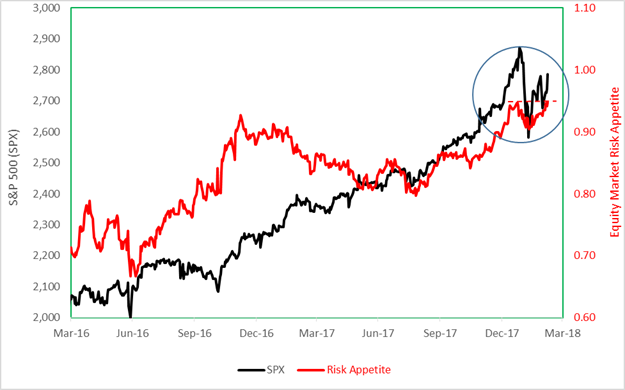Volatility paid off big last week.
How’s that old saw about March go? “In like a lion, out like a lamb”?
That certainly held true for last week’s weather in most of the U.S. And it was true for our stock market as well. The SPDR S&P 500 ETF (NYSE Arca: SPY) gained 3.6 percent on the week, but was outdone by the 4.9 percent upturn for its beta-tilted cousin, the PowerShares S&P 500 High Beta ETF (NYSE Arca: SPHB).
We’ve examined SPHB before—the last time was in our February 27 article, “Did Low-Volatility Strategies Fail Investors?”—usually in contrast to its stablemate, the PowerShares S&P 500 Low Volatility ETF (NYSE Arca: SPLV). SPHB strips out 100 of the highest-beta stocks from the S&P 500, while SPLV takes the opposite tack with 100 S&P components exhibiting the lowest volatility. Last week, SPLV lagged with a 3.4 percent gain.
When we put SPHB’s price in ratio to SPLV’s, we get a real-time measure of investors’ risk appetite. Whenever SPHB gains over SPLV—signified by a rising ratio—the taste for market risk becomes more keen. Beta was certainly a flavorsome treat last week as it has been since the February market break. Regard the rebound of the risk appetite indicator (in red) below. It’s climbed back to its pre-break level while the S&P 500 has yet to overcome its drawdown.

And it’s no wonder. Take a look at the stocks driving the S&P 500 and, by extension, SPY. SPY’s top five components earn an average 1.12 beta coefficient. SPHB’s top five come in nearly twice as hot with a mean 2.05 reading.
So the question now is whether March and the market go out like lambs. Forecasting weather is always a dicey business but my Farmer’s Almanac calls for “unsettled conditions” in the Northeast as March winds down. The Almanac says nothing about stock volatility, however.











Leave A Comment